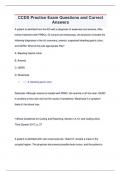CCDS Practice Exam Questions and Correct
Answers
A patient is admitted from the ED with a diagnosis of weakness and anemia. After
further treatment with PRBCs, GI consult and endoscopy, the physician includes the
following diagnoses in the d/c summary: anemia, suspected bleeding gastric ulcer,
and GERD. What is the post appropriate Pdx?
A. Bleeding Gastric Ulcer
B. Anemia
C. GERD
D. Weakness
✓ ~~~ A. Bleeding gastric ulcer
Rationale: Although anemia is treated with PRBC, the anemia is d/t the ulcer. GERD
is ancillary to the ulcer and not the cause of symptoms. Weakness if a symptom
likely d/t the blood loss.
*Official Guidelines for Coding and Reporting, Section I.A.15, and Coding clinic,
Third Quarter 2017, p. 27
A patient is admitted with new-onset seizures. Head CT reveals a mass in the
occipital region. The physician documents possible brain tumor, and the patient is
,transferred to another hospital for further workup. What is the most appropriate
diagnosis?
A. Seizure
B. Neoplasm of occipital region
C. Head mass
D. Head tumor
✓ ~~~ B. Neoplasm of occipital region
Rationale: Per the Official Guidelines for Coding and Reporting Section II.H
Uncertain Diagnoses, the seizure is a symptom of the possible brain tumor. Head
mass and head tumor are not as specific as neoplasm of occipital region.
A hospital's base rate, or blended rate, is:
1. Calculated annually
2. Dependent on indirect costs for graduate medical education and new technology
3. Adjusted based on number of low-income patients
4. Adjusted based on capital profits
A. 1 & 2
B. 2 & 3
C. 1, 2, & 3
,D. 1, 2, 3, and 4
✓ ~~~ C. 1, 2, & 3
Rationale: According to CMS, base rates are calculated annually and include
adjustments for operating expenses and capital expenses, including graduate
medical education and care for the indigent.
The final MS-DRG assigned to a patient's medical record should:
A. Reflect the amount of time the physician spent with the patient
B. Depend on the patient's length of stay
C. Be assigned by the physician
D. Reflect the patient's severity of illness (SOI) and the resources used in the
patient's care
✓ ~~~ D. Reflect the patient's severity of illness (SOI) and the resources used in the
patient's care.
Rationale: Per CMS, based on documentation of conditions being monitored and
treated during the inpatient admission, coding professionals translate the
documentation into ICD-19-CM/PCS codes that group to the final MS-DRG
regardless of the patient's length of stay or the amount of time a provider spend
providing care. The final MS-DRG is assigned after discharge.
, A patient is admitted from the ED with a diagnosis of acute respiratory failure and
aspiration pneumonia due to an overdose of pain medication. What is the most
appropriate Pdx?
A. Acute respiratory failure
B. Aspiration pneumonia
C. Poisoning related to medication
D. Reflect adverse effect of medication
✓ ~~~ C. Poisoning related to medication
Rationale: When coding a poisoning or reaction to the improper use of a medication
(ex. overdose, wrong substance given or taken in error, wrong rout of
administration), first assign the appropriate code from categories T36-T50.
A patient is admitted with pneumonia, stage 1 chronic renal failure, chronic anemia,
and COPD. While hospitalized, the patient received IV abx, inhalers, O2, IVFs at
50ml/hr., and iron tablets. Which conditions should be coded?
A. PNA only
B. PNA and COPD only
C. PNA, COPD, anemia
D. PNA, CKD stage 1, anemia, COPD
✓ ~~~ D. PNA, CKD stage 1, anemia, COPD




